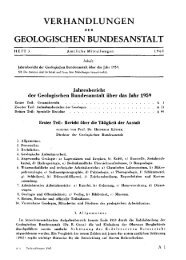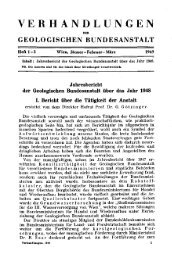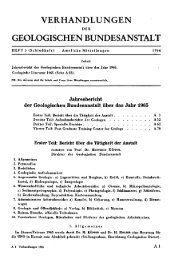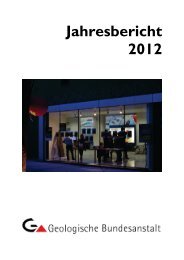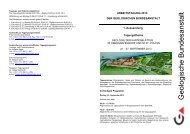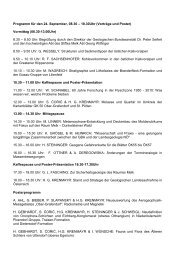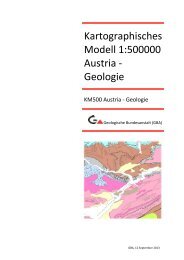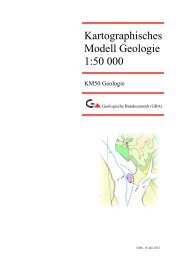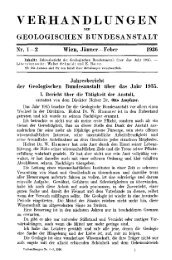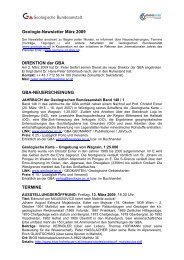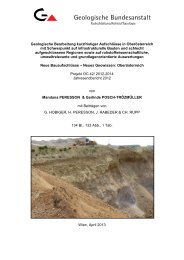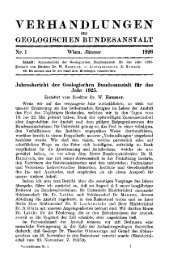Field Trip B TRIASSIC CONODONT LOCALITIES OF THE ...
Field Trip B TRIASSIC CONODONT LOCALITIES OF THE ...
Field Trip B TRIASSIC CONODONT LOCALITIES OF THE ...
You also want an ePaper? Increase the reach of your titles
YUMPU automatically turns print PDFs into web optimized ePapers that Google loves.
anee of Gladigondolella tethydis. It is a long ranging zone corresponding to the upper Austriacum Zone<br />
(Julian 2/H), the Dilleri and the lower Subbullatus Zones (Tuvalian 2/1) in terms of ammonoid zonation.<br />
Gondolella nodosa-Zone<br />
The range of Gondolella nodosa defines this zone which can be divided by the latter appearance of<br />
Epigondolella primitia.<br />
4. Lower Nodosa-Assemblage Zone:<br />
This time marked by the presence of abundant G. polygnathiformis and rare G. nodosa is a correlative<br />
of the upper Subbullatus Zone (Tuvalian 2/H) and the lower Anatropites-Bereich. (Tuvalian 3/1).<br />
Samples from the Hallstatt Lst. generally rich in platform conodonts allow a more precise correlation<br />
with the ammonoid stratigraphy by changing frequency rates of the two conodont species: In the Tuvalian<br />
2/II the ratio between G. polygnathiformis and G. nodosa is approx. 10:1, in the Tuvalian 3/1 it<br />
is 3-5:1.<br />
5. Upper Nodosa-Assemblage Zone:<br />
This subzone is defined by the appearance of E. primitia and further occurrences of G. nodosa and<br />
rare G. polygnathiformis. The upper subzone is a short ranging correlative of the upper Anatropites-<br />
Bereich (lower Tuvalian 3/II).<br />
6. Metapolygnathus communisti morphotype A-Zone<br />
This zone correlates to the range of the index species which is most frequent in all samples studied.<br />
Other platform conodonts are Epigondolella primitia and rare Epigondolella abneptis. So far this short<br />
time interval is known at Feuerkogel, Slovakia, Yugoslavia (Sarajevo) and Timor. At both, Feuerkugel<br />
and Timor the zone correlates to the upper part of the upper Anatropites-TSereich (upper Tuvalian 3/II)<br />
and basalmost Norian. The short Norian portion has been easily recognized in all sections studied by<br />
the sudden und rich appearance of Gondolella navicula which evidently indicates the base of the Norian<br />
Stage.<br />
Norian<br />
7. Metapolygnathus communisti morphotype B-Zone<br />
This species is an index to the lowermost Norian and corresponds well to the Lacian 1/1 ammonoid<br />
zone. Associated with the name bearer are Epigondolella primitia, E. abneptis and frequent Gondolella<br />
navicula. At yet this zone has only been recognized at Feuerkogel where it has been found at different<br />
places.<br />
8. Epigondolella /vi/raYw-Assemblage Zone<br />
The base of this zone is defined by the disappearance of Metapolygnathus communisti morphotype<br />
B which, by comparison with the ammonoid stratigraphy, shortly extends into the upper Jandianus Zone<br />
(Lacian 1/H). The platform conodont fauna is composed of E. primitia, E. abneptis s. str. and Gondolella<br />
navicula; the latter may also be missing sometimes. This zone seems of worldwide utility because<br />
the index species is distributed as far as Canada and Western North America (MOSHER 1973).<br />
9. Epigondolella a. abneptis-Assemblage Zone<br />
This zone is marked at its base by the disappearance of Epigondolella primitia and contemporaneously,<br />
by the beginning of Epigondolella abneptis spatulata. The base of the zone is not correlative to<br />
the base of the Paulckei Zone directly, but somewhat younger. Though no further distinct separation<br />
is possible a more detailed correlation with the two ammonoid levels of the Paulkei Zone is suggested<br />
by different ratios of the two subspecies: In the Lacian 2/1 subzone E. a. abneptis is frequent and E. a.<br />
spatulata rare whereas the Lacian 2/H subzone contains reverse frequency ratios.<br />
10. Epigondolella a. spatulata-Assemblage Zone<br />
The base of this zone is defined by the appearance of Epigondolella postera and by abundant representatives<br />
of E. a. spatulata. Furthermore, this zone is the exclusive level for Gondolella hallstattensis.<br />
In terms of ammonoid stratigraphy it corresponds to the uppermost Paulckei and the Magnus Zones.<br />
Epigondolella postera- Assemblage Zone<br />
This zone is subdivided into two faunal units, the lower and upper Postera Assemblage Zones.<br />
11. Lower Postera Assemblage Zone<br />
The subzone is marked at its base by the appearance of Gondolella steinbergensis and by a change<br />
in the relative abundance ratios of the two subspecies of E. abneptis: E. a. abneptis becomes frequent<br />
79



